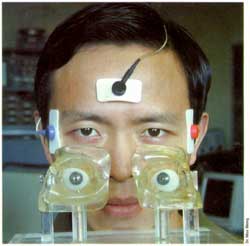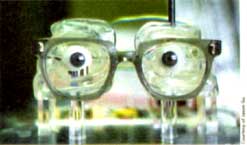|
Biological Signals Acquisition |
EOG tests >
Applications |
| |
One possible application:
artificial eyes and recreation of "natural" eye movement. |
| |
|
| |
|
The
first robotic eye implant to mimic the movement of a
real human eye
(Adapted from the Medical Post, Volume 36, No. 29, September
5, 2000) |
|
In most cases eye replacement patients (who have just lost the
eyeball) benefit from a moveable artificial eye called the
Bio-eye hydroxyapatite ocular implant which has been available
since the 1980s. The Bio-eye is made of porous material
like coral which the body grows into. Muscles attach to the
artificial eyeball and allow a good range of movement in
synchrony with the normal eye. But for less than 1% of the
people needing an artificial eye and who have lost the entire
content of an orbit, including the muscle, fat, bone and nerve
due to extensive cancer or trauma, such a technology is not
possible.
These patients have to endure the social stigma of a static,
staring artificial eye.
|
 |
|
Note,
here, the positioning of the electrodes, which
permit recording of lateral eye movements
(left-right) |
|
Detection
of the Natural Eye's Movement: |
| |
|
 |
A team of engineers
from the University of Alberta designed the first robotic eye
implant to mimic the movement of a real human eye. The robotic
eye detects and follows the movement of the remaining natural
eye. |
|
There is a very small motor that drives the artificial eyeball
which is mounted in the socket where the person's eye used to
be. The tiny motor sits inside the hollow sphere of the
artificial eyeball on a shaft, about which the eye rotates
horizontally.
Its motion is driven by information sent by the natural
eye's movement and received by a small computer chip in the
artificial eye. |
|
One
method to detect the natural's eye movement, is to have an
infrared sensor array mounted on a pair of eyeglasses transmit
data about the eye's position to the robotic eye.
With another newer method, electrodes sense the electrical
signals sent from the brain to the natural eye to cause
movement and forward the information to the artificial eye.
Both methods are tested outside of the body using input from
natural eyes to move artificial ones mounted in plastic eye
pits.
The newer system using the electrical signals from the eye
offers net cosmetic advantages: it would get rid of the
external device (the eyeglasses) and use the human signal
itself internally. The aim would eventually be to eliminate
the electrodes used outside of the body and get the signal
from the eye socket only. (Work published in the August issue of Robotics
and Autonomous Systems)
|